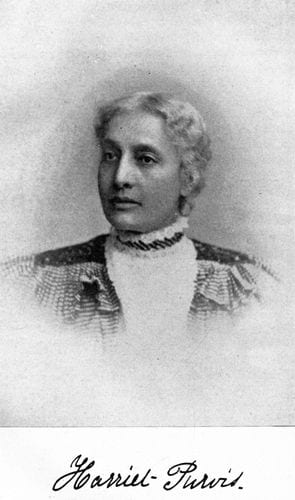
Basic Information
During a time when the world needed brave souls, Harriet Forten Purvis was born. Along with her family, she made leaps and bounds in the abolition movement. Not only did she provide a good life for her immediate family, but she cared for distant family as well. Her life goal was not to have a better life for herself, but to fight for the freedom of others.
Background Information
Harriet Forten Purvis was born in Philadelphia, Pennsylvania in 1810. She was born into a privileged African American family, her parents, “inventor and businessman James Forten and educator and abolitionist Charlotte Vandine Forten” (Harriet, 2017). She had two sisters as well and all of them were involved in some form of abolitionist activism. She married Robert Purvis on September 13, 1831 and had a total of eight children. She also raised her niece Charlotte Forten who later became a well-known poet and activist as well.
Contributions to the First Wave
As discussed above, Purvis was heavily involved in activism with one of her largest achievements happening on December 9, 1833 when the Philadelphia Female Antislavery Society was founded. The society was founded in the presence of Purvis, her two sisters, and her mother among five other women and became the first biracial women’s society. In whole, “the constitution they adopted set forth their firm belief that slavery and prejudice were contrary to the laws of God and the Declaration of Independence” (The Philadelphia, 2019).They provided funds to assist many slaves who were fleeing from the south with clothes, food, and transportation as well as a school taught by Sarah Douglass (The Philadelphia, 2019). The final meeting of this organization was on March 21, 1870 shortly after the civil war had ended with the 13th, 14th, and 15th constitutional amendments being put into place. The closing statement was delivered by Margaretta Forten saying “’the object for which this Association was organized is thus accomplished, therefore resolved, that the Philadelphia Anti-Slavery Society, grateful for the part allotted to it in this great work, rejoicing in the victory which has concluded the long conflict between slavery and Freedom in America, does hereby disband’” (The Philadelphia, 2019). Among her significant involvement in outspoken abolition work it was also said that “the household of Robert and Harriet Forten Purvis became a major haven for abolitionists and fugitive slaves alike” which is not surprising considering practically her entire family was involved in abolition work (Brotherly love. Ultimately, her life was not just her own, but one of her race and her sex. Not to mention the involvement she had in speaking alongside Sojourner truth with her sister Margaretta Forten. While they did speak to the people about women’s rights their speeches were not recorded. For that reason we as a people need not forget that “the sisters helped to lay the groundwork for the first National Woman’s Rights convention ever held, in October 1854” (Wheeler, 1995, 139). Purvis was also very involved in the American Equal Rights Association along with her daughter Hattie Purvis. The AERA was founded in 1866 at a women’s rights convention and campaigned for women’s suffrage. They worked alongside Frances Harper, Sojourner Truth, and even some men to grant women the right to vote (Wheeler, 1995, 139).
The sisters helped to lay the groundwork for the first National Woman’s Rights Convention ever held
-One Woman, One Vote (Wheeler, 1995, 139)
Analysis and Conclusion
Purvis’ dedication to the abolitionist movement played a major part in the women’s first wave movement as well. She spoke out for those she cared about and at the same time spoke out for other women just like her. While the words she spoke are not saved on paper, the ripple effect that she had on the women’s movement will forever be engraved in its success. Even her family provided the success of the Underground railroad, her son Charles was the African American to oversee a civilian hospital, and her niece Charlotte was a well-known activist and poet (Harriet, 2017). For that reason, Harriet Forten Purvis, her siblings, and her children are major examples of what it took to fight for the equality of not just race, but for everyone.

Philadelphia Female Antislavery Society played a ground breaking part in the Anti-slavery movement and seal representing this society is pictured above.
References
Brotherly Love. PBS, Retrieved May 02, 2019, from https://www.pbs.org/wgbh/aia/part3/3p477.html
Harriet Forten Purvis. (2017, April 02). History of American Women. Retrieved May 03, 2019, from http://www.womenhistoryblog.com/2016/08/harriet-forten-purvis.html
Image of Harriet Forten Purvis (1810-1875), Retrieved May 18, 2019, from https://upload.wikimedia.org/wikipedia/commons/c/cb/Harriet_Forten_Purvis_%281810-1875%29.jpg
The Library Company of Philadelphia. (2019). Retrieved May 18, 2019, from https//explorepahistory.com/displayimage.php? imgId=1-2-69F
The Philadelphia Female Anti-Slavery Society founded. (n.d.). African American Registry. Retrieved May 2, 2019, from https://aaregistry.org/story/the-philadelphia-female-anti-slavery-society-founded/
Wheeler, M. S. (1995). One Woman One Vote: Rediscovering the Woman Suffrage Movement. Troutdale, Or: NewSage Press.